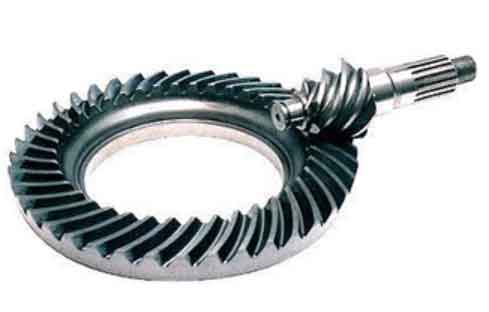Hypoid gears offer several advantages that make them a preferred choice in certain applications. Let’s explore the advantages of hypoid gears in more detail:

- Efficiency: Hypoid gears provide high efficiency in power transmission. The sliding motion between the gear teeth reduces friction compared to other gear types, resulting in minimal power loss during operation. This efficiency is especially beneficial in applications where maximizing power transfer is crucial, such as automotive differentials or industrial gearboxes.
- Torque Transfer: Hypoid gears can transmit high torque levels efficiently. The offset design of the gear axes allows for increased gear engagement, leading to a larger contact area and higher torque capacity. This makes hypoid gears suitable for applications that require the transmission of heavy loads and high torque, such as in heavy machinery or power transmission systems.
- Quiet Operation: The sliding motion of hypoid gears contributes to their quiet operation. The reduced rolling contact between gear teeth reduces noise and vibration compared to other gear types. This is particularly advantageous in applications where noise reduction is desired, such as in power tools, automotive drivetrains, or consumer appliances.
- Compact Design: Hypoid gears offer a more compact design compared to other types of gears. The non-intersecting axes of hypoid gears allow for a more compact gear assembly, which can be beneficial in space-constrained applications. The compact design also helps in achieving more efficient and lightweight gearboxes.
- Versatility in Shaft Orientation: Hypoid gears allow for non-parallel and non-intersecting shaft orientations. This versatility in shaft placement makes them suitable for applications where the input and output shafts need to be positioned at different angles. This feature enables engineers to design more flexible and compact systems, especially in automotive, marine, and industrial applications.
- Durability: Hypoid gears are designed to handle heavy loads and provide durability in demanding applications. The larger contact area and tooth engagement of hypoid gears distribute the load more evenly, reducing the risk of localized wear and improving gear life. This makes them suitable for applications that experience high loads, such as in heavy machinery, construction equipment, or off-road vehicles.
- High Gear Ratios: Hypoid gears can achieve high gear ratios, allowing for significant speed reductions in a compact space. This makes them suitable for applications that require large speed reductions or where space constraints limit the size of the gear assembly.
- Versatile Applications: Hypoid gears find application in various industries, including automotive, industrial machinery, power tools, marine, and more. Their advantages make them well-suited for applications that require efficient power transmission, high torque capacity, compact design, and versatility in shaft orientation.
It’s important to note that hypoid gears may have some limitations as well, such as slightly lower mechanical efficiency compared to certain gear types and the need for specific manufacturing processes and expertise. However, when the advantages of hypoid gears align with the requirements of an application, they offer efficient and durable solutions for power transmission needs.
To fully harness the advantages of hypoid gears, it is recommended to work with experienced gear manufacturers and design engineers who can optimize the gear geometry, material selection, lubrication, and other factors specific to the application. This ensures that the hypoid gears are tailored to meet the specific performance and reliability requirements of the system.
